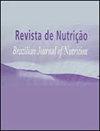Development and validation of a food frequency questionnaire for children aged 7 to 10 years
IF 0.5
4区 医学
Q4 NUTRITION & DIETETICS
Revista De Nutricao-brazilian Journal of Nutrition
Pub Date : 2022-01-01
DOI:10.1590/1678-9865202235e210020
引用次数: 0
Abstract
ABSTRACT Objective Food and nutritional evaluation of children can support public policies to combat early overweight and obesity. This study developed and validated a quantitative food frequency questionnaire for assessing the dietary intake of children. Methods This is a cross-sectional study of the development of a food frequency questionnaire for 130 children of both genders aged 7 to 10 years old. For the food frequency questionnaire list, 81 food items were selected. The validity of the food frequency questionnaire was evaluated by comparison with 24-hour recalls and reproducibility was performed by comparing two food frequency questionnaires. Results Most of the foods with 95% relative contribution were ultra-processed, such as packaged snacks and powdered juice. In validation, correlation coefficients were found between 0.45 (p<0.000) for lipids and 0.37 (p<0.000) for carbohydrates. An adjustment for energy reduced the correlations, but there was an increase in the correlation in calcium (r=0.75) and retinol (r=0.20). In terms of reproducibility, all macronutrients and calcium showed a satisfactory intraclass correlation coefficient (>0.400) and moderate correlations [proteins (0.54; p<0.000) and lipids (0.41; p<0.000)]. Conclusion The food frequency questionnaire developed was valid and able to assess the local food consumption by children from northeastern Brazil.7至10岁儿童食物频率问卷的编制和验证
【摘要】目的对儿童进行食物和营养评价,为制定防治早期超重和肥胖的公共政策提供依据。本研究开发并验证了定量食物频率问卷,用于评估儿童的膳食摄入量。方法采用横断面研究方法,对130名7 - 10岁男女儿童进行食物频率问卷调查。食物频率问卷表选取了81种食物。采用24小时召回法对问卷的效度进行评价,并对两份问卷的重复性进行比较。结果相对贡献率为95%的食品多为超加工食品,如包装零食和果汁粉。在验证中,相关系数在0.45 (p0.400)和中度相关[蛋白质(0.54;P <0.000)和脂质(0.41;p < 0.000)。结论所编制的食物频率问卷是有效的,能够评估巴西东北部儿童的当地食物消费情况。
本文章由计算机程序翻译,如有差异,请以英文原文为准。
求助全文
约1分钟内获得全文
求助全文
来源期刊
CiteScore
1.20
自引率
12.50%
发文量
24
审稿时长
6-12 weeks
期刊介绍:
Revista de Nutrição is former Revista de Nutrição da Puccamp, founded in 1988. It is a bimonthly publication every four months and it is of responsibility of the Centro de Ciências da Vida, da Pontifícia Universidade Católica de Campinas . It publishes articles that contribute to the study of Nutrition in its many sub-areas and interfaces; and is open to contributions of the national and international scientific communities.

 求助内容:
求助内容: 应助结果提醒方式:
应助结果提醒方式:


